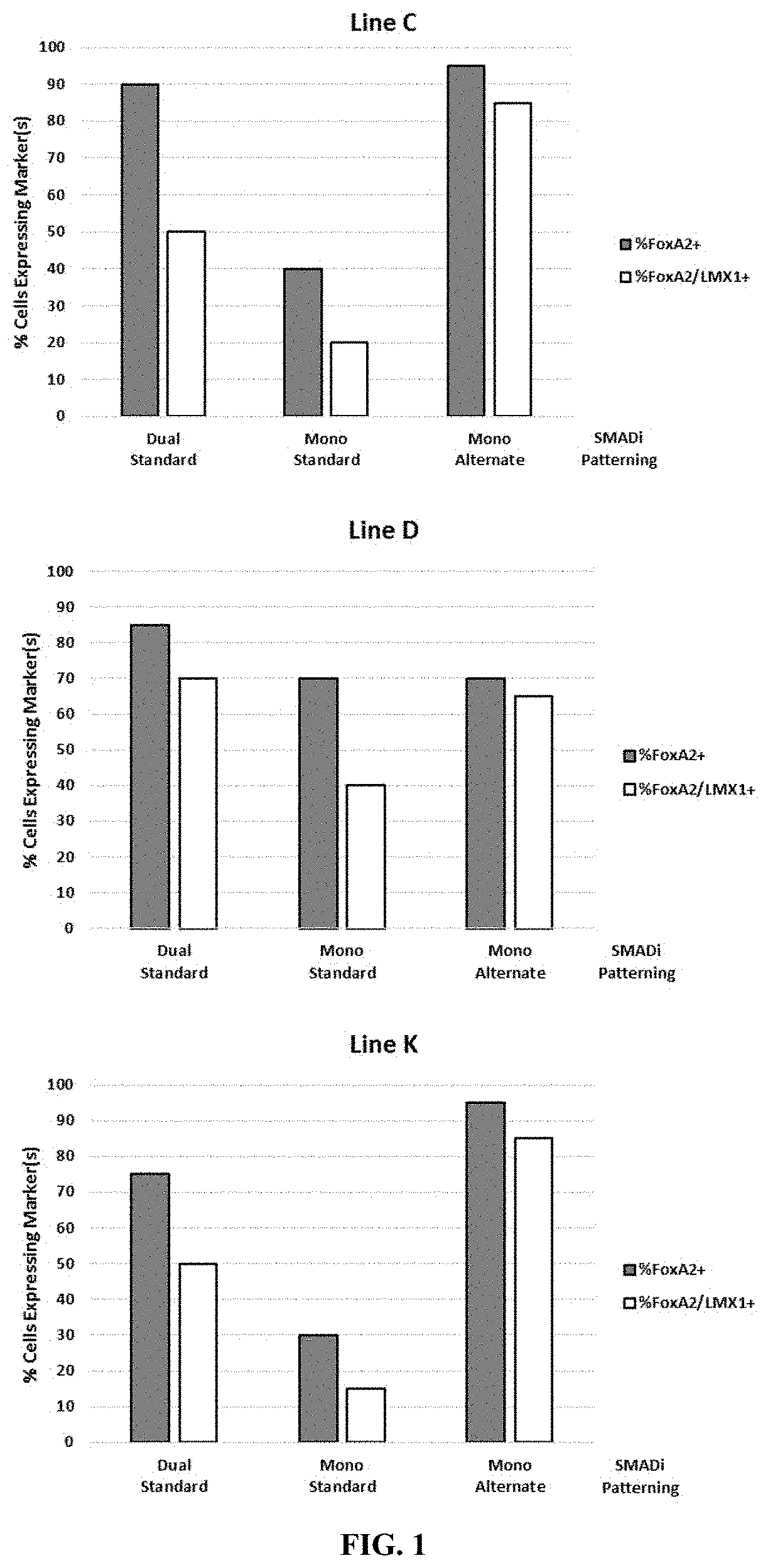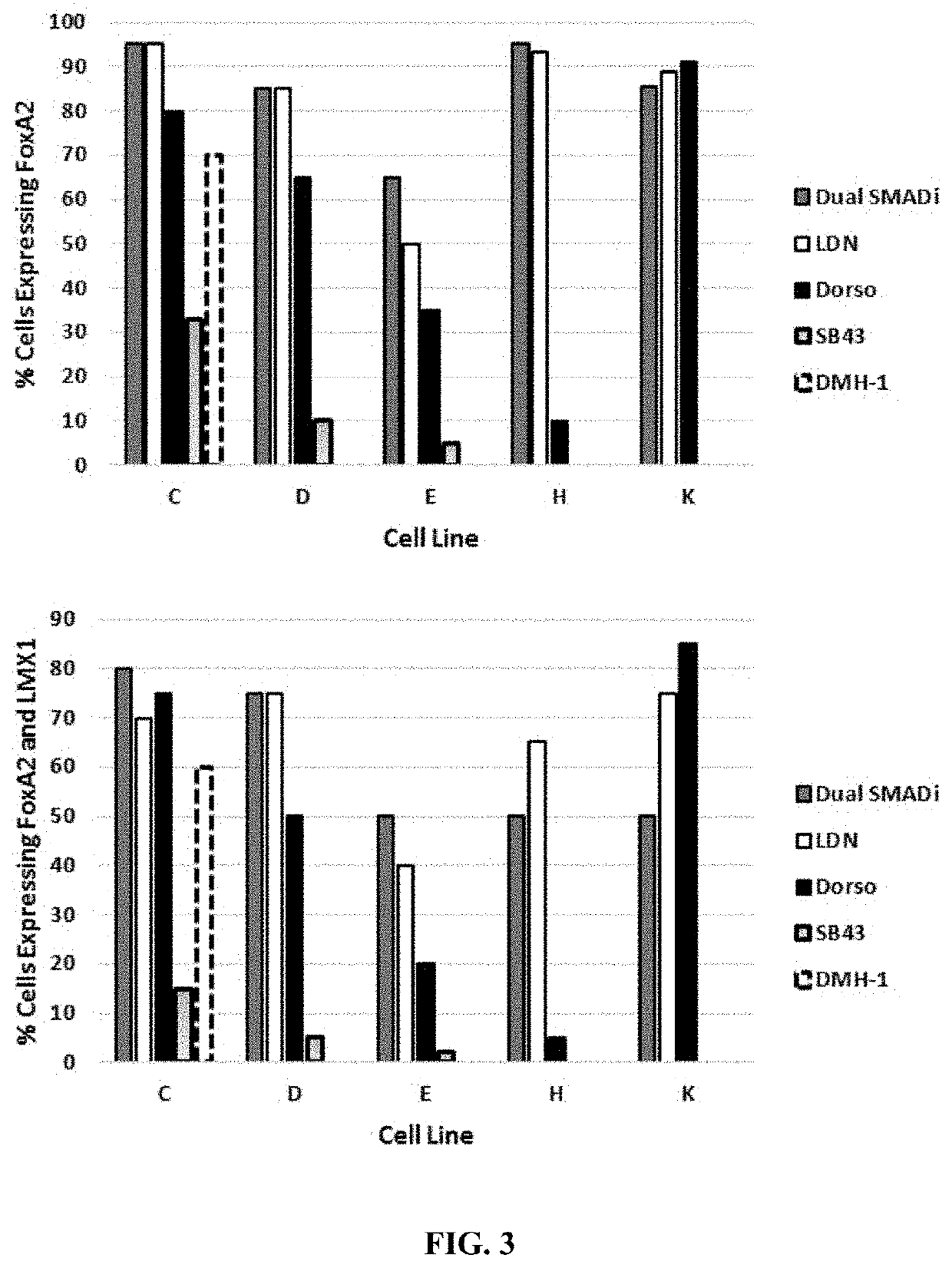Methods for differentiating pluripotent cells
a technology of pluripotent cells and methods, applied in the field of molecular biology and medicine, can solve the problems of failure to achieve the effect of cell differentiation
- Summary
- Abstract
- Description
- Claims
- Application Information
AI Technical Summary
Benefits of technology
Problems solved by technology
Method used
Image
Examples
example 1
Materials and Methods
[0151]Midbrain neuronal differentiation of human induced pluripotent stem cell (iPS) cell lines expanded on VTN-TN in Essential 8 medium was performed with small molecule and growth factor induction using a variety of differentiation media compositions and schedules as detailed in Tables 1-5. Generally, the iPS cells were cultured in D1 DA Neuron Induction Medium on Day 1, D2 Neuron Induction Medium on Day 2, and D3-D4 DA Induction Medium on Day 3 and 4. On Day 5, the cells were dissociated with TrypLE for 15 minutes and collected in DA Quench Medium before transferring the cells to a spinner flask suspension culture to form aggregates in D5 DA Neuron Aggregate Formation Medium.
[0152]On Day 6, the aggregates were settled, about 66% of the medium was removed, and the aggregates were fed DA Neuron Induction Medium. On Days 7-16, the aggregates were fed daily with DA Neuron Aggregate Maintenance Medium, and the medium was changed on Day 11 through 16. On Day 17, ag...
example 2
Efficient mDA Progenitor Patterning Using Mono-SMADi
[0160]Efficient patterning of mDA progenitors, as measured by the percentage of cells co-expressing FoxA2 and Lmx1 on process day 17, is generally required for obtaining a highly enriched population of mDA neurons at the end of the manufacturing process. If the majority of the cells on day 17 are not mDA progenitors, the neurons obtained will have a large population of non-midbrain phenotype neurons, or will have an outgrowth of proliferative cells that typically leads to neuron detachment or difficulties or an inability to purify the post-mitotic neurons.
[0161]The iCell DopaNeurons process was optimized with most progenitor patterning factors added starting on day 1. This includes factors for neuralization (dual-SMADi), sonic hedgehog signaling (Shh, PMN), and Wnt signaling (CHIR). However, the inventors found that this approach did not work well for almost all iPSC lines tested in the context of neuralization using mono-SMAD inhi...
example 3
Determination of Inhibitors for Mono-SMAD Inhibition
[0167]Different inhibitors were tested for function in mono-SMADi methods, as follows. The iCell DopaNeurons process induces neuralization using LDN-193189, an inhibitor of BMP signaling (inhibits ALK 1 / 2 / 3 / 6, blocks SMAD 1 / 5 / 8), and SB-431542, an inhibitor of TGF-b signaling (inhibits ALK 4 / 5 / 7, blocks SMAD 2 / 3). Together, this is referred to as “dual SMAD inhibition”, or “dual SMADi.” To define optimal conditions for neuralization using only a single SMAD inhibitor in the mDA process, various analogs of LDN-193189 and SB-431542 were screened across multiple iPS cell lines using the alternate patterning conditions described above. As shown in FIG. 3, LDN-193189 was observed to be the inhibitor that was best overall at inducing the highest percentage of mDA progenitors when tested across different iPSC lines. For the data shown with one SMAD inhibitor, LDN-193189, Dorsomorphin, and DMH-1 were added to the media for Days 1 through 1...
PUM
 Login to View More
Login to View More Abstract
Description
Claims
Application Information
 Login to View More
Login to View More - R&D
- Intellectual Property
- Life Sciences
- Materials
- Tech Scout
- Unparalleled Data Quality
- Higher Quality Content
- 60% Fewer Hallucinations
Browse by: Latest US Patents, China's latest patents, Technical Efficacy Thesaurus, Application Domain, Technology Topic, Popular Technical Reports.
© 2025 PatSnap. All rights reserved.Legal|Privacy policy|Modern Slavery Act Transparency Statement|Sitemap|About US| Contact US: help@patsnap.com



